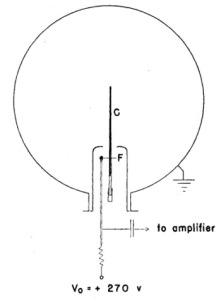Purpose of the flight and payload description
This mission was part of a series of simultaneous flights carried out during July and August 1951 at Bismarck, North Dakota, Thule, Greenland and from the ship USS Wyandot going north from Boston aimed to study the fluctuations and latitude effect of cosmic rays at high altitudes and latitudes.
The payload transported by this balloon was an automatic ionization chamber, which can be seen schematically at left. It consisted of a steel spherical shell, 25 cm in diameter, having a wall thickness of 0.5 mm, and filled to a pressure of 8 atmospheres of argon. The ion collector (C) was a conducting quartz rod, the lower end of which was left uncoated for insulation purposes.
A small conducting quartz fiber (F) was normally maintained at a potential of 270 volts. As the collector (C) loses charge by collecting negative charges from the ionized gas, the fiber moves closer until it becomes unstable due to image forces, rapidly touches (C), charging it again, and flies away. When contact was thus made a pulse was generated across a series resistor and this pulse was amplified and transmitted. At the maximum rate of ionization during a balloon flight, this recharging occured every 15 to 20 seconds.
In all flights was included a barometer unit consisting of a good commercial, three-section bellows whose expansion was measured by a series of contacts. The unit provided approximately 20 barometer signals for a change of one atmosphere pressure.
Details of the balloon flight
Balloon launched on: 8/6/1951
Launch site: Bismarck, North Dakota, US
Balloon manufacturer/size/composition: Zero Pressure Balloon
End of flight (L for landing time, W for last contact, otherwise termination time): 8/6/1951
External references
- Fluctuations and Latitude Effect of Cosmic Rays at High Altitudes and Latitudes Phys. Rev. 90, 655 (1953)
10938If you consider this website interesting or useful, you can help me to keep it up and running with a small donation to cover the operational costs. Just the equivalent of the price of a cup of coffee helps a lot.


